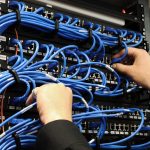In this article, we will explore the concept of data cabling, its importance in modern infrastructure and the common questions people ask regarding its implementation and maintenance. As businesses and individuals increasingly rely on complex networks for communication and connectivity, data cabling becomes an indispensable component of technological infrastructure. To fully grasp the critical role of data cabling, it’s essential to consider its impact on network reliability, speed and future technological adaptation.
Why Is Data Cabling Important?
Enhancing Network Reliability
Data cabling serves as the backbone of network infrastructure, ensuring consistent and reliable connectivity. Well-maintained cabling networks can significantly reduce the risk of downtime and connectivity issues, which are costly in terms of business operations. Additionally, reliable data cabling supports seamless communication between devices, an essential factor for the smooth functionality of any digital environment.
Network reliability is further enhanced by the strategic planning and installation of these cables. Skilled technicians are indispensable in implementing cable layouts that minimize interference and signal degradation. Both businesses and residential users benefit from a network that offers solid dependability and minimised latency through effective data cabling solutions.
The reliability of a network often directly correlates with the quality of its cabling. Inadequate or outdated cabling can bottleneck information flow, degrading overall network performance. Consequently, investing in quality cabling as part of a well-thought-out infrastructure strategy ensures that both current and future connectivity demands are met effectively.
Supporting High-Speed Data Transfer
With the advancement of technology, robust cabling is necessary to support high-speed data transfer within networks. As internet speeds and bandwidth needs continue to rise, high-quality data cables enable the expeditious transmission of extensive data volumes. Networks equipped with superior cabling solutions can accommodate a broader range of digital applications, from video conferencing to streaming services, without compromising performance.
High-speed data transfer is imperative for maintaining competitive advantage in fields ranging from cloud computing to video game design. For businesses, rapid data transmission is crucial, as delays could hinder productivity or impact consumer satisfaction. Moreover, with the increasing prevalence of data-heavy tasks like real-time analytics and AI processing, robust data cabling becomes a fundamental contributor to operational efficiency.
Future-proofing your network’s capacity for high-speed data transfer is achievable through strategic cabling choices. Fibre optic and advanced copper cables are integral in these strategies, offering the bandwidth required for emerging technological trends. Ultimately, investing in high-speed data transfer capabilities is essential for any organization aiming to keep pace with modern technological demands.
What Are the Types of Data Cables?
Copper Cables
Copper cables are commonly used due to their reliability and cost-effectiveness, with types like Cat5, Cat6 and Cat7 catering to various speed and distance requirements. These cables have been a mainstay in networking environments largely because of their durability and affordability. They offer adequate performance for many residential and commercial applications, providing a widely accessible solution for basic connectivity needs.
Each copper cable type offers different advantages, balancing speed, distance and cost to meet specific requirements. For example, Cat6 cables can support Gigabit Ethernet, while Cat7 cables are designed for higher frequencies and greater shielding against interference. Despite their limitations, copper cables remain a versatile choice that can accommodate upgrades without necessitating complete infrastructural change.
While copper cables may not match the data speed capabilities of fibre optics, their widespread availability and flexibility sustain their relevance in many scenarios. In spaces where installing fibre optics isn’t feasible or necessary, copper provides an effective alternative for completing network setups. Thus, copper cables continue to play a crucial role in the global data cabling landscape.
Fibre Optic Cables
Fibre optic cables provide higher speeds and are ideal for long-distance data transmission, making them crucial for certain network configurations. Composed of thin strands of glass or plastic, these cables transmit data as pulses of light, vastly improving speed and bandwidth over significant distances. This technology is particularly beneficial for data centres, ISPs and institutions requiring immense data throughput and minimal latency.
Beyond speed and distance, fibre optics offer enhanced security benefits due to the complexity of intercepting light signals. This makes them an excellent choice for transmitting sensitive information across corporate or governmental networks. As demand for streaming services, video conferencing and cloud-based applications continues to grow, fibre optics provide the necessary backbone to support these high-bandwidth activities.
Although fibre optic cables generally involve greater upfront costs, their long-term advantages in speed, reliability and maintenance present compelling reasons for investment. Industries that rely heavily on intricate and voluminous data transfers find fibre optics indispensable for efficient operations.
Data cabling is a critical component of modern infrastructure. Understanding its importance and the different types available can help in making informed decisions that enhance connectivity and support future growth. By investing in the right cabling solutions, organizations create robust networks capable of supporting current demands and seamlessly adapting to future technological advances, ensuring long-term operational excellence and competitiveness.



